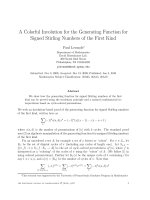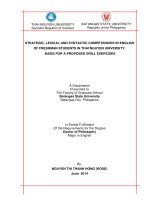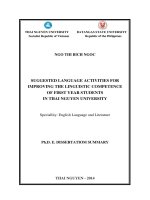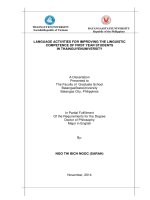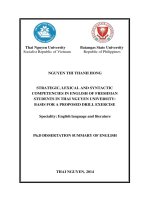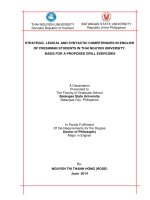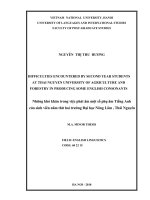language activities for improving linguistic competence of the first year students in thai nguyen university (sum)
Bạn đang xem bản rút gọn của tài liệu. Xem và tải ngay bản đầy đủ của tài liệu tại đây (250.77 KB, 25 trang )
NGO THI BICH NGOC
SUGGESTED LANGUAGE ACTIVITIES FOR
IMPROVING THE LINGUISTIC COMPETENCE
OF FIRST YEAR STUDENTS
IN THAI NGUYEN UNIVERSITY
Speciallity: English Language and Literature
Ph.D. E. DISSERTATIOM SUMMARY
THAI NGUYEN - 2014
THAI NGUYEN UNIVERSITY BATANGAS STATE UNIVERSITY
Socialist Republic of Vietnam Republic of the Philippines
The study was done at:
INTERNATIONAL GRADUATE STUDY PROGRAMS,
THAI NGUYEN UNIVERSITY
Scientific supervisor: Dr. Matilda H. Dimaamo
The peer review 1:
The peer review 2:
The peer review 3:
The dissertation is defended to the Panel of Experts at:
Dissertation can be found at:
National Library
Learning Resource Center, Thai Nguyen University
Library of International Training and Development Center
Library of Batangas State University, Philippines
1
“ In this summary dissertation, all figures and tables are
numbered as in dissertation”
In our world today language is our mean of communication
and learning. It is one’s knowledge and a tool of expressing of
thoughts and perception. Thoughts and ideas can never be expressed
and can not be understood by one another without good language.
Because it enables people to communicate and express themselves, it
becomes an important part of any society.
Learning other languages besides national language is also of
vital importance since it helps to have additional knowledge of other
people and cultures.
Considered as the international language, English now is
chosen by many people and in learning it as the second language.
One of most difficulties of the students in learning English are related
to their problems of linguistics and words formation and in order to
have a good command of this language, students need to have
opportunities to improve their ability of these skills.
Thus, the theme “Language Activities for improving Linguistic
Competence of the First Year Students in Thai Nguyen University” is
chosen to study
The structure of dissertation includes 5 chapters
2
CHAPTER 1: INTRODUCTION
1. THE PROBLEM
Language is considered important because it is the vehicle for
communication between countries, cultural groups, organization,
communities and friends. Language is used to give information to
people around us, expressing feelings, desires, and questions as well
as understanding the world.
In learning English as a foreign language, students most
common difficulties encountered are attributed to the interference of
their mother tongue like Vietnamese language particularly in
pronunciation, syntax, and usage; their lack of opportunity also to use
the English language in some communication or situations in their
daily lives; the kind of English lessons taught by their teachers, their
being passive listeners, their lack of confidence in the language; and
their irresponsibility in their own learning.
These causes can also be related to other issue like that of their
lack of understanding of words or vocabulary. It is believed that
students’ vocabulary increase when they elaborate their conceptual
knowledge based on known words; relate new words to known concepts
to deep understanding of words and connect with other concepts.
On the other hand, students need to have good intuitive
command of morphology. They have knowledge in specific
morphemic elements and its combinations. They can explore on the
use of prefixes and suffixes and based words and on Greek and Latin
prefixes for them to be provided with valuable prior knowledge in
their learning of new terminologies. Students with better
3
understanding on word formation such as prefixes, suffixes and roots
have the tendency to acquire larger vocabularies and better
comprehension in compared to those who do not have such
background, knowledge and skills.
As a College teacher of Thai Nguyen University teaching Basic
English, I am interested to investigate the level of linguistic competence
of students in terms of connotation, denotation, antonyms, synonyms,
and ambiguities as well as the level of students’ understanding on word
formation related to acronym, clipping, blending, and compounding with
the end view of proposing language activities to enhance their linguistic
performance. This prompted the researcher to conduct the study.
2. STATEMENT OF PROBLEM
This study attempts to determine the level of Linguistic
Competence of the First Year Students at Thai Nguyen University.
Specifically, it seeks to answer the following questions:
1. What is the level of linguistic competence of students in the
teacher - made test using the following:
1.1 . connotation
1.2 . denotation
1.3 . antonyms
1.4 . synonyms,
1.5 . ambiguities, and
1.6 . vocabulary
4
2. What is the level of understanding of students on word-formation
in terms of :
3.1. acronym
3.2. clipping
3.3. blending
3.4. compounding
3. Which among the items in the different cluster students find
most difficult?
4. How do the teachers assess the linguistic competence of the
students?
5. Is there a significant difference between teachers’
assessment and students’ competencies?
6. What English language activities may be suggested to
improve students’ understanding of English words and concepts?
3. SCOPE, DELIMITATION AND LIMITATION
The study covered the level of linguistic competency of Thai
Nguyen University first year students. The output of the study is the
proposed language activities to enhance the linguistic competency of
first year students of Thai Nguyen University.
The respondents included in the study were the 382 First year
College students taking up Basic English course in Thai Nguyen
University system in the Academic Year 2013-2014. Results of this
study were limited only on the data gathered from these respondents
5
4. SIGNIFICANT OF THE STUDY
This study is believed to have significant to the Administrators
of Thai Nguyen University. the First Year Students, Basic English
Teachers, Parents of the First Year Students and future researcher.
Administrators. Findings of this study will provide relevant
input for them to be able to design an effective curriculum for the
students.
First Year Students of TNU. Students will be informed on
their weaknesses so that they can devise ways to improve their
linguistic performance.
Faculty Teaching Basic English. Results of this study will
provide relevant information to the faculty teaching Basic English to
design their own instructional material to enhance the linguistic
proficiency of students.
Parents of First Year Students of TNU. Findings of this
study will provide them the weaknesses of their children so that they
may provide proper guidance and motivation for their children’s
improvement.
Future Researchers. Future researchers may use this study to
broaden their knowledge in the field linguistic.
6
CHAPTER II: REVIEW OF LITERATURE
1. REVIEW OF RELATED STUDIES
This section presents of some literatures related to the topic
2. RESEARCH PARADIGM
INPUT PROCESS OUTPUT
Figure 1. Research Paradigm
The research paradigm explains the relationship of the input-
process-output of the study. The input covers the level of linguistic
competence including connotation, denotation, antonyms, synonyms,
ambuigities and vocabulary. Also part of the input is the level of
understanding of students on word formation employing acronyms,
Assessment
Through
-Survey
Questionnaire
- Teacher-
made
Test
Language
Activities
a
1. Level of
Linguistic
Competence using
the following:
- connotation
- denotation
- antonyms
- synonyms
- ambiguities
- vocabulary
2. Level of
understanding of
students on word -
formation:
- acronym
- clipping
- blending
- Compounding
7
clipping, blening and compounding, The process bos involvesthe
assessment of the level of lingistic competence and word formation
of the students. These were assessed through survey questionnaire,
teacher-made test. Finally, form the relationship of the first two
boxes emerge the third box of the paradigm that illustrates the output
of the study, the suggested language activities.
CHAPTER III: RESEARCH METHOD AND PROCEDURE
1. RESEARCH DESIGN
This study made used of descriptive method of research to
determine the level of Linguistic Competence of the First Year
Students at Thai Nguyen University.
According to Dr. Y.P. Aggarwal (2008) descriptive research is
devoted to the gathering of information about prevailing conditions
or situations for the purpose of description and interpretation. This
type of research method is not simply amassing and tabulating facts
but includes proper analyses, interpretation, comparisons,
identification of trends and relationships.
In this study, level of linguistic competence of first year
college students of Thai Nguyen University System in terms of
connotation, denotation, antonyms, synonyms, and ambiguities as
well as the level of students’ understanding on word-formation in
terms of acronym, clipping, blending, and compounding were
determined. These were assessed through survey questionnaire and
teacher-made test. The output of the study was in the form of
language activities to improve students’ linguistic competency.
8
2. SUBJECT OF THE STUDY
The subjects of the study comprised of three hundred eighty
two first year students taking up Basic English course in five
universities namely; Thai Nguyen University of Education (TUE),
Thai Nguyen University of Information and Communication
Technology (ICTU), Thai Nguyen University of Sciences (TUS), and
Thai Nguyen University of Medicine and Pharmacy (TNUMP) at
Thai Nguyen University system during the first semester Academic
Year 2013-2014.
Table 1: The distribution of sample respondents
Universities
Students
Teachers
Population
Proportionate
allocation
Population
Proportionate
Allocation
University of Education
2200
98
22
22
University of
Telecommunication and
Information Technology
1300
58
16
16
University of Sciences
1400
63
10
10
University of Agriculture
and Forestry
2500
112
11
11
University of Medicine
and Pharmacy
1140
51
7
7
Total
8540
382
22
22
9
As shown in the table, a total of 382 student respondents and
66 teacher respondents were selected from the given population. The
sample size was calculated using the Slovin’s formula: n= N/ 1+N*e
2
where n is the sample size, N is the given population and e is the
desired error. For the student respondents, 382 questionnaires were
retrieved however, six questionnaires were not answered completely
and thus, were excluded from the data analysis. For the teacher
respondents, all the questionnaires were answered completely and
thus, all the 66 responses were included in the analysis.
3. DATA GATHERING INSTRUMENT
The main instrusment used in gathering was questionnaire
checklist for teacher and the teacher - made test for students to
determine the level of students in linguistic competence and word
formation and teachers’ assessemnet of students results.
The questionnaire checklist consists of 2 parts.
Part 1: consists of personal information such as gender, age,
eduactinal qualification and years of teaching experience
Part 2: consists of teachers’ assessment of luanguage
competence of students; the frequency of language competency
assessment and the degree of importance
Based on the view of literature and related study, the
researcher designed a set of questinnaire checklist to collect the data
with the following scales
10
Table 2: Scale of values of frequency of language competency
assessment
Scale
Range Inteval
Verbal interpretation
5
4.50 – 5.00
Always
4
3.50 – 4-49
Very often
3
2.50 – 3.49
Often
2
1.50 – 2.49
Seldom
1
1.00 – 1.49
Not at all
Table 3: Scale of values of the degree of importance
Scale
Range Inteval
Verbal
interpretation
5
4.50 – 5.00
Very important
4
3.50 – 4-49
Moderately
important
3
2.50 – 3.49
Slightly important
2
1.50 – 2.49
Less important
1
1.00 – 1.49
Not important
Teacher Made Test consits of 2 parts:
Part 1: Consists consists of personal information such as
gender, age and schoo
Part 2: Consists of questions on language competence and
word formation of the students in terms of denotation, connotation,
11
antonyms, synonyms, vocabulary, acronyms, clipping, blending and
ccompounding
This was used in evaluating student respondents to determine
their level of linguistic competency and level of understanding on
word formation. Linguistic competency has the following
components: Connotation, Denotation, Antonyms, Synonyms,
Ambiguities and Vocabulary. Word formation, on the other hand has
been defined as the process by which new lexical bases are formed as
well as the structure of complex lexical bases, particularly those
composed of more than one morphological element (Huddleston and
Pullum, 2002). It is a term in linguistics (particularly morphology)
which denotes of the ways in which new words are made on the basis
of other words or morphemes. Among the common types of word -
formation are: Acronym, Clipping, Blending and Compounding.
In constructing the Teacher Made Test for linguistic
competency and word formation, test questions were obtained and
modified from different books dealing with the topic and class notes.
Ten questions were formulated for each of the above listed
components of language competency and word formation.
4. DATA GETHERING PROCEDURE
Concepts and literatures were read to deepen knowledge and
understanding about the present study. Books, journals, other
reading references, published and unpublished researches and online
references were used to come up with the present research.
The study made used of two data gathering instruments
namely survey questionnaire for teacher respondents and teacher-
12
made test for student respondents. In the development of the
questionnaire and teacher made test, the first draft prepared was
submitted to the adviser for comments and suggestions. The two
instruments were reviewed and checked in line with their contents
and statement of the problem.
The survey questionnaire for teachers and test for students
were presented to the practitioners for content validation. The survey
questionnaire was submitted to English teachers for comments and
suggestions for further improvement. Likewise, the teacher-made
test for student respondents was pilot tested to other students not the
respondents of the study to determine the strength and weaknesses of
the instrument. These two instruments were validated by experts
before administration to the respondents. The score of each item was
given a corresponding weight value with one as the lowest and five
as the highest. Descriptive equivalents or verbal descriptions were
also provided for the interpretation of results.
Prior to the distribution of the two instruments, the following
procedures were done. Permissions to conduct the study from the
administrators of different universities were sought. Upon granted
approval, questionnaires were distributed. There was a separate
schedule for student and teacher respondents. As soon as the
questionnaires were answered by the teachers and the students,
questionnaires were retrieved. Then items in the questionnaire were
checked and then tallied for interpretation and analyses.
5. STATISTICAL TREATMENT OF DATA
The study applied the following statistical treatment:
13
Coefficient of Correlation. This was used to evaluate the
relationship between the teachers’ perceptions and the students’
performance in the linguistic test.
Frequency, percentage and rank. These were used to
present the descriptive characteristics of the respondents’ level of
linguistic performance and understanding of word formation.
Linear Regression. This was used to validate the t-test
analysis and coefficient of correlation.
Standard Deviation. This was utilized to estimate the degree
of homogeneity or heterogeneity of students’ performance.
Student’s t-test. This was used to test the significance of the
means score of teachers’ assessment versus the students’
performance in the linguistic test.
Weighted Mean. This was used to determine the students’
level of linguistic performance
CHAPTER IV: RESULTS AND DISCUSSION
1. LEVEL OF LINGUISTIC COMPETENCE OF FIRST YEAR
STUDENTS
The levels of linguistic competence of First year students of
the six universities in TNU Vietnam was assessed along the areas of
connotation, denotation, antonyms, synonym, and ambiguities and
vocabulary.
In the area of connotation, result of 68 % of the correct answer
indicates that students have an average level when it comes to the
14
study of connotation. They were able to have an understanding of the
words even without the aid of dictionary. They are able to give the
meanings of words without encountering so much difficulty because
of their personal experiences.
As regard to denotation the result of 68% of the correct answer
shows that TNU students’ performed at an average level in this kind
of test. This indicates that students have developed skills and
sensitivity in recognizing literal meanings of English words far better
than their implied meanings, traits that are typical expected for
developing language learners.
As for antonyms, the score obtained of 64.4% correct answer
indicates that the student respondents did possess cognitive skill
expected of their educational level. This further indicates that student
respondents do possess good background as regard to the study of
words and their meanings as they got average scores in all three
concerned areas. Students can identify the opposite of the word
without having difficulty.
In the test area of synonym, the result of 69 % implies that
among the different test areas, it is where the student respondents
showed the best performance. Synonym would be the easiest and
would require the least cognitive skills
For ambiguities, the result means that while the students have
developed their basic linguistic skills as exemplified in synonymy,
they have also developed their advance linguistic skills as they have
shown in ambiguity. The results also reflects further on the effective
teaching and learning practices of the teachers and the students along
these areas as the students were able to demonstrate an average level
of linguistic competence.
15
For vocabulary, the result indicates that the students generally
have developed their vocabulary to a level that they can respond
correctly to tertiary level words. When compared with the scores in
other test areas, it is as equally high as the scores in denotation,
ambiguity, and synonyms This not only shows consistency in
expectation but also provides independent validation of the students’
linguistic skills. Thus, the similarities in performance in these areas
affirm the linguistic level of the students to be average and at par
with their tertiary status.
2. LEVEL OF UNDERSTANDING OF STUDENTS ON WORD
FORMATION
The students’ level of understanding with regards to word
formation was evaluated using four areas namely: acronym, clipping,
blending and compounding.
As for acronyms, the score suggests an average level of
knowledge with regards to the use of acronyms. Among the test areas
in word formation, this area has the lowest numerical value and could
indicate this as one of the more difficult areas under this topic. The
average performance of the student respondents in this case indicates
that they have substantially acquired word formation skills pertinent
to acronyms at par with their tertiary level. This further implies that
students do not understand how words are coined and they also lack
exposure to some common coined words.
This reflects on the familiarity of the students on the use of
acronyms possibly from the influence of media which makes them
aware of the common meanings and usage of certain English words.
16
Among the test areas in word formation, this area has the lowest
numerical value and could indicate this as one of the more difficult
areas under this topic.
With regards to clipping, the result indicates that the students
have an average level of understanding with regards to the use of
clipping in word formation. The student performance in clipping is
one of the high scores next to compounding.
The students’ test achievement in blending on the other hand
is implied that students did not find difficulty in finding the origins of
clipped words and can indicate the pattern used in this kind of word
formation.
In the test for compounding, the score that is above 50 percent
with a verbal interpretation of average suggests that the students have
an average level of understanding with regards to the use of
compounding. Among the four areas of word formation, this is the
area where the students demonstrated the best performance.
The results from the word formation test indicate that while the
students have developed their linguistic skills, they have acquired
more advanced word formation skills that would complement their
linguistic skills to make effective their communicative skills.
3. ITEMS IN THE DIFERENT CLUSTER STUDENTS FIND
MOST DIFFICULT
It can be observed that for connotation, the most difficult item
is item 8 with 56 percent correct score from a population of 376
students. This result shows students’ unfamiliarity and understanding
17
of its connotation. One reason for the unfamiliarity of the students is
students do not have many chances to use it
For Denotation, the most difficult item is item 20. The words
clod and lump are two words that appear to be unfamiliar to the
students. One reason for this unfamiliarity could be that these words
are rarely used in farming.
The most difficult item in the test area of antonyms is item 28
with a correct score of 51 percent. The words restrictive and
liberating are two contrasting words that appear to be unfamiliar to
the students.
For synonyms, the most difficult item is item 34 with 64
percent of correct scores. This item indicates that among the different
test areas, this is the area the students find least difficult.
In the case of Ambiguities, the most difficult item is item 44.
This item has a correct score of 56 percent. The framing of ideas in
the statement can be confusing to the learner. This can be from the
difference in sentence construction in Vietnamese
For the Vocabulary test, the most difficult item is item 55 with
59 percent of correct answer. This means that the students did not
find the vocabulary test to be extremely difficult. This could be
because these students are at the middle stages of English language
learning and they have already a certain degree of usable English
vocabularies.
It the word formation test, it can be observed that for acronym,
the most difficult item is item 69. This item has a correct score of 49
percent from a Spopulation of 376 students. It is the item with the
18
lowest correct score in all test areas including the linguistic test areas
and vocabulary. For clipping, the most difficult item is Item 74. The
correct score for this item is 67 percent which is the top among the
most difficult items in word formation. This means that among the
different test areas in word formation, it is this area that has the least
difficult items.
The most difficult item in the test area of blending is item 87.
This item has a correct score of 55 percent and is the next lowest
scoring item among the different test area of word formation. The
difficulty of this item in blending stems from the relative similarities
of the choices that creates confusion to the students.
For compounding, the most difficult item is item 93. This item
has a correct score of 62 percent. This indicates that among the
different test areas, this is the item with a moderate level of difficulty.
Learning the old words in the dictionary is not enough since new
English words are being invented everyday through this process of
word formation.
4. TEACHER ASSESSMENT OF THE LIGUISTIC
COMPETENCE OF THE STUDENTS
It can be observed that all the 20 items obtained an agree score
of >50 percent. High agree scores were obtained in the component B
items as compared to the primary A items. This means that the
abstract understanding of the teacher about the meaning of the items
is less compared to their understanding based on example
Relative to the rate of the teacher respondents as to the
frequency students utilize their linguistic skills. The result means that
19
linguistic skills are not as frequently used or practiced by the students
as perceived by the teacher respondents. The item with the highest
frequency score is item 5 with a mean score of 3.05 and standard
deviation of 0.57. This means that among the different linguistic skills,
this is the area that is well developed among the students as perceived
by the teachers. Meanwhile, the items with the least frequency are
items 1 and 2, where both have means score of 2.55 and a rank of 9.5.
This means that the students have the least linguistic skills in these
areas among the different skills being evaluated.
As regard to the ratings of teacher respondents according to the
degree of importance. These scores obtained for the rating based on
the degree of importance are generally higher than the mean scores
obtained for the frequency and indicate the low ratings of students’
skills versus the perceived importance of these skills by the teachers.
The result indicates tat the approach that the teachers are doing in
teaching linguistic skills based on their degree of importance is
reflective of the frequency of use and skills development of the
students. . The data suggest that in developing the linguistic skills of
students, they have to be aware that some of these skills can be
readily learned by the students while others would take longer time to
learn and need more motivation in order to be absorbed and
frequently practiced by the students.
5. RELATIONSHOP BETWEEN THE TEACHER’S
ASSESSMENT AND THE LEVEL OF STUDENTS’
LINGUISTIC COMPETENCES
In the relationship between the teachers’ assessment and the
level of students’ linguistic and word formation competencies, it can
20
be observed that there is no relationship exists between them. This
also indicates that for this population of respondents, the teachers’
perception was not predictive of the students’ performance in the
different areas of linguistic competence.
One of the reasons for this disparity is the tendency of the
teachers to downgrade the frequency rating of the students. It is
possible that the teachers were unable to properly observe and
estimate the frequency by which the student use their linguistic and
word formation skills. It is also possible that the students have
alternative learning mechanisms or venues like the media such as
broadcast or printed media or the internet, that promote the advanced
development of the students linguistic skills and not just classroom
based; that is why the student’s performance in the linguistic tests
were high and incongruent with the low frequency observations of
the teachers in class.
6. LANGUAGE ACTIVITIES THAT CAN BE PREPARED
TO IMPROVE THE STUDENTS’UNDERSTANDING OF
ENGLISH WORDS AND CONCEPTS
In designing the appropriate language activities to improve the
students’ understanding of English words and concepts especially on
this population of Vietnamese teachers and students, some criteria
must be considered. These are: to include areas in linguistic
competencies where the students showed poor performance; and
include those items that show the highest rank among the most
difficult items in the cluster. The four linguistic skill areas are
connotation, antonyms, acronym and denotation.
21
Language activities were designed based on the three indicated
skill areas. It can be noted that all two skills areas belong to linguistic
skills and one from word formation skills It was only in these three
areas that the students need language activities for them to cope with
their skills requirement to be at par with their status as second
language learners of English.
CHAPTER V: SUMMARY, FINDING AND
RECOMENDATION
1. SUMMARY
This study attempts to determine the level of Linguistic
Competence of the First Year Students at Thai Nguyen University for
the school year 2014.
Specifically, it seeks to answer the following questions:
1) What is the level of linguistic competence using the
following:
1.1. connotation,
1.2. denotation
1.3. antonyms
1.4. synonyms
1.5. ambiguities
1.6. vocabulary.
22
2) What is the level of understanding of students on word-
formation in terms of
2.1. acronym
2.2. clipping
2.3. blending
2.4. compounding.
3) Which among the items in the different cluster students
find most difficult?
4) How do the teachers assess the linguistic competence of
the students?
5) Is there a significant difference between teachers’
assessment and students’ competencies?
6) What English language activities may be suggested to
improve students’ understanding of English words and concepts?
2. FINDINGS
The research found out that the over-all linguistic performance
of the students is generally better, as the students were able to
demonstrate an average level of linguistic competence.
Students have average level of understanding in word
formation.
The items found most difficult under the cluster of linguistic
competence are items (8) for connotation (20) for denotation,
antonyms (28), synonyms (34), and ambiguities (44). For vocabulary
cluster is item (55), while for word formation cluster, the items that are
23
found to be most difficult are the following: acronym item (69),
clipping (74), blending (87), and compounding (93).
Linguistic skills are not frequently used or practiced by the
students as perceived by the teacher respondents.
There’s no relationship exists between the teacher’s
assessment and the level of students’ linguistic competencies as
indicated by the significance of the p-value at 0. 05 levels and the
language activities that composed of set of exercises were designed
for improving students’ linguistic competencies in the areas of
connotation, antonyms and acronyms
3. RECOMMENDATION
Based on the findings and conclusions of the study, the
following are the recommendations:
1. Provide students with exposures on varied learning activities
to enhance further their linguistic competencies.
2. The developed language activities be presented to language
teachers for further suggestions.
3. Further study maybe conducted on other components of
communicative competence.



